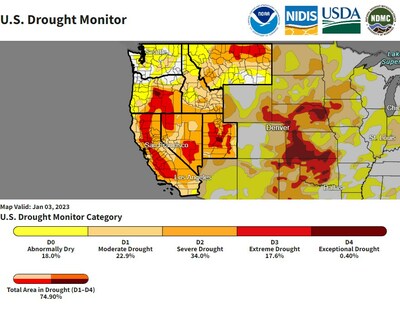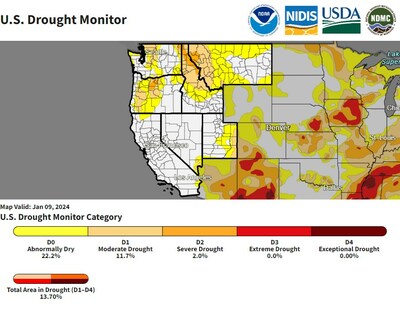TERMINIX® REVEALS TOP PEST THREATS ACROSS PACIFIC COAST AND MOUNTAIN WEST STATES
Roof Rats, Termites and Cockroaches are thriving in changing environmental conditions
Roof Rats
Roof rats are highly prevalent across the western part of the
Roof rats are commensal rodents, living near and dependent upon the human habitat for survival. When these rodents infest homes, they can be found in attics, eaves and on rooflines. The most common identifying characteristic of a roof rat is their tail. Roof rat tails are hairless and longer than the combined length of their head and body, whereas the tails of other rats are hairy and shorter than their head and body.The best way to avoid invasions of roof rats is to provide as little harborage as possible. Limit access to open food, ensure all trash is disposed of in closed containers and seal as many holes and cracks on the outside of the home through which rats might enter.
The problem with roof rats is intensified by their adaptability to human dwellings and changing environmental areas. These rodents are smart but predictable and often seek out the safest travel patterns while trying to stay hidden. Increased urbanization along the
In addition to increased urbanization, the regulatory ban issued in
Drywood Termites:
Drywood termites are a species of termite that typically makes its home in dry wood that forms the structural foundation of a home, as well as within wooden fixtures and furniture inside a home. These insects are most often found above ground and, unlike subterranean termites, do not need to make contact with soil in order to thrive. Drywood termites are usually found around coastal and other humid regions.
Although drywood termite colonies do not develop as rapidly as other species of termites, these pests can expand quickly and cause extensive damage to homes and businesses. A clear sign of a drywood termite infestation is the collection of frass, or granular fecal matter, on the floor or flat surface below the wood they are inhabiting. These pests need areas with high humidity as they get all their water by extracting it from the wood. As drought stricken areas continue to decrease in western states, Drywood termites have begun spreading to regions they have not been seen before. This migration highlights the adaptability of pests to environmental conditions as a recurring theme in these insights.
Their ability to cause extensive damage adds to the challenges faced by homeowners and business owners alike. Being proactive is the best form of prevention. However, if signs of termite damage are spotted or suspected contact a trusted pest management expert as soon as possible.
Cockroaches:
The
Oriental and American cockroaches are persistent. American cockroaches tend to like more damp, steamy and warmer weather, highlighting the vulnerability of areas no longer impacted by extreme dryness. These pests typically enter a home or business from the exterior. Signs of a potential cockroach infestation may include: droppings (cylindrically shaped, black, about two-millimeters in size), smear marks (brown and irregularly shaped), shed skin or an unusual smell.
Aside from being a nuisance, these insects can carry bacteria and pathogens like E. coli and salmonella. Due to their ability to carry disease, anything a cockroach walks across, including food, can become contaminated adding a public health dimension to the pest challenge. When dealing with cockroaches, addressing the issue at its source becomes imperative to prevent further migration and potential disease transmission.
Roof rats, drywood termites, and cockroaches pose significant pest challenges in the Pacific and Mountain West region, especially with the ongoing changes in environmental conditions. Roof rats, identified by their unique tail and adaptability to human habitats, are increasingly prevalent along the coast due to the climate conditions and urbanization. Drywood termites, thriving in dry wood structures, present a costly threat to home and business owners. Climate changes contribute to their migration to places these termites have never been seen in before, emphasizing the adaptability of these pests. Cockroaches, who can be carriers of bacteria, pose additional risks especially in areas that are no longer impacted by extreme dryness due to the changing environmental factors. Addressing these concerns at their source is vitally important for safe and effective pest control. Overall, the adaptability of these pests underscores the importance of staying vigilant and implementing tailored strategies in response to the changing conditions, to ensure the well being of homes and business in this region.
For more pest tips, or to learn more about local pest management resources, please visit Terminix.com.
About Rentokil Terminix
Rentokil Terminix is the leading provider of residential and commercial services in
EnhancedPestControl.com , or linkedin.com/company/rentokilterminix.
MEDIA CONTACT: Hannah Bernhard
Hannah.Bernhard@rentokil.com
![]() View original content to download multimedia:https://www.prnewswire.com/news-releases/terminix-reveals-top-pest-threats-across-pacific-coast-and-mountain-west-states-302050721.html
View original content to download multimedia:https://www.prnewswire.com/news-releases/terminix-reveals-top-pest-threats-across-pacific-coast-and-mountain-west-states-302050721.html
SOURCE Terminix



